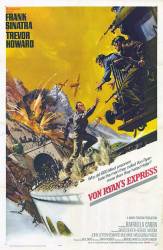Factual error: Sergeant Bostick tells Colonel Ryan he is from the 113th Armored Division. The U.S. Army never had a 113th Armored Division in WW2.
Other mistake: When Ryan arrives at the camp he observes a funeral taking place yet when he goes to meet the camp Commandant he asks what they are celebrating outside.
Suggested correction: I would agree that a funeral is not really an occasion for "celebration." The British regiment are holding a funeral for one of their dead officers: they are speaking English, and since Colonel Ryan is a US soldier, he can fully understand what they are saying, and he should know what is going on. He has worked out that a funeral service is in progress, but, having only just arrived at the POW camp, he will not know all the details of what is going on, and might be interested to know more. It might be insensitive to ask one of the British soldiers, so he decides to ask one of the Italian guards instead. Now, Colonel Ryan's history previous to the start of the film is not described, but he must have experienced some harrowing events in his military career, and this has probably left him feeling cynical and bitter, so he is probably using sarcasm. After all, Colonel Ryan is rather sarcastic throughout the rest of the film, too.






Suggested correction: Is this actually an error? I believe the British Regiment who feature in this film are The Ninth Fusiliers. Well, there never has been a Ninth Fusiliers in the British army, either! For that matter, there never was a Colonel Joseph L Ryan, or a Major Eric Fincham, or a Major Battaglia. While this film is set in the Second World War, it is openly admitted that it is a wholly fictional story. Some Second World War films (A Bridge Too Far; The Longest Day; The Battle Of the Bulge) were made to recreate historical events, and so refer to soldiers and military units who existed. Other Second World War films like this one (Sahara, Escape To Victory, Ice Cold In Alex) while referencing actual events, and, showing sequences of events that are not beyond probability, are still stories. Since this is a fictional, imagined story, is it acceptable for soldiers to serve with fictional regiments or imaginary fighting units?
While some fictional accounts can be taken for granted and not counted as errors (even films based on true stories can have fictional characters), there are limits when setting films in the past. To have a 113th Armored Division is a valid mistake as the highest number in WWII was the 20th Armored Division, unlike Infantry Divisions that went into the 100's. This could almost be the same as giving a character an 8 or 11 number phone number.
Bishop73
The anonymous drive by hit and run "contributor" (not referring to you, Bishop73) may not have seen another post I made about Sgt. Bostick wearing a 4th Armored Division patch on his uniform: he says he is from the 113th A.D. (which never existed) but wears the 4th A.D. patch, which did exist in WW2, but did not see service until France in 1944.
Scott215